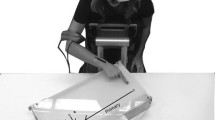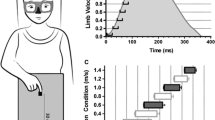Abstract
A modulation of the primary impulse of manual/video-aiming movements performed without visual feedback has been reported. In the present study, we show that this modulation is modified (a) with increased practice, (b) the use of an aligned visual display, and (c) the availability of visual feedback on alternated trials. However, this modulation was not as efficient as that observed in a normal vision condition, which underlines the primary role of vision to ensure endpoint accuracy. Moreover, this modulation was observed only on the extent component of the task. This last observation indicates that proprioception can be used to modulate the extent component of goal-directed movements but that vision is necessary to modulate their direction.


Similar content being viewed by others
Notes
As suggested by H. N. Zelaznik, in Experiment 3 we also looked at within-participant variability at every two percent of normalized movement time. The results of this analysis were similar to those reported in the present study. On the extent component of the task for both vision conditions there was a significant reduction in variability late in the movement suggesting a modulation of the movement’s primary impulse (see Selen et al. (2006) for similar results and interpretation). On the direction component of the task, only the normal vision condition resulted in a significant decrease in variability late in movement, which is also similar to the data reported in the main text. However, in this supplementary analysis the modulation of the movement’s primary impulse appeared earlier (near 50% of normalized movement time) than in the analyses reported in the main text.
References
Abahnini, K., & Proteau, L. (1999). The role of peripheral and central visual information for the directional control of manual aiming movements. Canadian Journal of Experimental Psychology, 53(2), 160–175.
Bagesteiro, L. B., Sarlegna, F. R., & Sainburg, R. L. (2006). Differential influence of vision and proprioception on control of movement distance. Experimental Brain Research, 171(3), 358–370.
Bédard, P., & Proteau, L. (2003). On the role of peripheral visual afferent information for the control of rapid video-aiming movements. Acta Psychologica, 113(1), 99–117.
Bédard, P., & Proteau, L. (2004). On-line vs. off-line utilization of peripheral visual afferent information to ensure spatial accuracy of goal-directed movements. Experimental Brain Research, 158(1), 75–85.
Bédard, P., & Proteau, L. (2005). Movement planning of video and of manual aiming movements. Spatial Vision, 18(3), 275–296.
Carlton, L. G. (1981). Processing visual feedback information for movement control. Journal of Experimental Psychology: Human Perception and Performance, 7(5), 1019–1030.
Cheng, D. T., Luis, M., & Tremblay, L. (2008). Randomizing visual feedback in manual aiming: reminiscence of the previous trial condition and prior knowledge of feedback availability. Experimental Brain Research, 189(4), 403–410.
Darling, W. G., & Cooke, J. D. (1987). Changes in the variability of movement trajectories with practice. Journal of Motor Behavior, 19(3), 291–309.
Desmurget, M., Epstein, C. M., Turner, R. S., Prablanc, C., Alexander, G. E., & Grafton, S. T. (1999). Role of the posterior parietal cortex in updating reaching movements to a visual target. Nature Neuroscience, 2(6), 563–567.
Desmurget, M., Rossetti, Y., Prablanc, C., Stelmach, G. E., & Jeannerod, M. (1995). Representation of hand position prior to movement and motor variability. Canadian Journal of Physiology and Pharmacology, 73(2), 262–272.
Elliott, D., & Allard, F. (1985). The utilization of visual feedback information during rapid pointing movements. Quarterly Journal of Experimental Psychology A Human Experimental Psychology, 37(3), 407–425.
Elliott, D., & Calvert, R. (1990). The influence of uncertainty and premovement visual information on manual aiming. Canadian Journal of Psychology, 44(4), 501–511.
Elliott, D., Carson, R. G., Goodman, D., & Chua, R. (1991). Discrete vs. continuous visual control of manual aiming. Human Movement Science, 10(4), 393–418.
Elliott, D., & Madalena, J. (1987). The influence of premovement visual information on manual aiming. Quarterly Journal of Experimental Psychology A Human Experimental Psychology, 39(3), 541–559.
Goodale, M. A., Pelisson, D., & Prablanc, C. (1986). Large adjustments in visually guided reaching do not depend on vision of the hand or perception of target displacement. Nature, 320(6064), 748–750.
Gordon, J., Ghilardi, M. F., Cooper, S. E., & Ghez, C. (1994). Accuracy of planar reaching movements. II. Systematic extent errors resulting from inertial anisotropy. Experimental Brain Research, 99(1), 112–130.
Guigon, E., Baraduc, P., & Desmurget, M. (2008). Computational motor control: feedback and accuracy. European Journal of Neuroscience, 27(4), 1003–1016.
Hansen, S., Glazebrook, C. M., Anson, J. G., Weeks, D. J., & Elliott, D. (2006). The influence of advance information about target location and visual feedback on movement planning and execution. Canadian Journal of Experimental Psychology, 60(3), 200–208.
Harris, C. M., & Wolpert, D. M. (1998). Signal-dependent noise determines motor planning. Nature, 394(6695), 780–784.
Heath, M. (2005). Role of limb and target vision in the online control of memory-guided reaches. Motor Control, 9(3), 281–311.
Khan, M. A., Elliott, D., Coull, J., Chua, R., & Lyons, J. (2002). Optimal control strategies under different feedback schedules: kinematic evidence. Journal of Motor Behavior, 34(1), 45–57.
Khan, M. A., Franks, I. M., & Goodman, D. (1998). The effect of practice on the control of rapid aiming movements: Evidence for an interdependency between programming and feedback processing. Quarterly Journal of Experimental Psychology A Human Experimental Psychology, 51(2), 425–443.
Khan, M. A., Lawrence, G., Fourkas, A., Franks, I. M., Elliott, D., & Pembroke, S. (2003). Online versus offline processing of visual feedback in the control of movement amplitude. Acta Psychologica, 113(1), 83–97.
Lateiner, J. E., & Sainburg, R. L. (2003). Differential contributions of vision and proprioception to movement accuracy. Experimental Brain Research, 151(4), 446–454.
Lemay, M., Gagnon, S., & Proteau, L. (2004). Manual pointing to remembered targets.but also in a remembered visual context. Acta Psychologica, 117(2), 139–153.
Lhuisset, L., & Proteau, L. (2002). Developmental aspects of the control of manual aiming movements in aligned and non-aligned visual displays. Experimental Brain Research, 146(3), 293–306.
Lhuisset, L., & Proteau, L. (2004). Planning and control of straight-ahead and angled planar movements in adults and young children. Canadian Journal of Experimental Psychology, 58(4), 245–258.
Lyons, J., Hansen, S., Hurding, S., & Elliott, D. (2006). Optimizing rapid aiming behaviour: Movement kinematics depend on the cost of corrective modifications. Experimental Brain Research, 174(1), 95–100.
Mackrous, I., & Proteau, L. (2007). Specificity of practice results from differences in movement planning strategies. Experimental Brain Research, 183(2), 181–193.
Messier, J., & Kalaska, J. F. (1997). Differential effect of task conditions on errors of direction and extent of reaching movements. Experimental Brain Research, 115(3), 469–478.
Messier, J., & Kalaska, J. F. (1999). Comparison of variability of initial kinematics and endpoints of reaching movements. Experimental Brain Research, 125(2), 139–152.
Meyer, D. E., Abrams, R. A., Kornblum, S., Wright, C. E., & Smith, J. E. (1988). Optimality in human motor performance: Ideal control of rapid aimed movements. Psychological Review, 95(3), 340–370.
Neely, K. A., Tessmer, A., Binsted, G., & Heath, M. (2008). Goal-directed reaching: Movement strategies influence the weighting of allocentric and egocentric visual cues. Experimental Brain Research, 186(3), 375–384.
Novak, K. E., Miller, L. E., & Houk, J. C. (2002). The use of overlapping submovements in the control of rapid hand movements. Experimental Brain Research, 144(3), 351–364.
Novak, K. E., Miller, L. E., & Houk, J. C. (2003). Features of motor performance that drive adaptation in rapid hand movements. Experimental Brain Research, 148(3), 388–400.
Papaxanthis, C., Pozzo, T., & McIntyre, J. (2005). Kinematic and dynamic processes for the control of pointing movements in humans revealed by short-term exposure to microgravity. Neuroscience, 135(2), 371–383.
Prablanc, C., & Martin, O. (1992). Automatic control during hand reaching at undetected two-dimensional target displacements. Journal of Neurophysiology, 67(2), 455–469.
Proteau, L. (2005). Visual afferent information dominates other sources of afferent information during mixed practice of a video-aiming task. Experimental Brain Research, 161(4), 441–456.
Proteau, L., & Isabelle, G. (2002). On the role of visual afferent information for the control of aiming movements toward targets of different sizes. Journal of Motor Behavior, 34(4), 367–384.
Proteau, L., & Masson, G. (1997). Visual perception modifies goal-directed movement control: Supporting evidence from a visual perturbation paradigm. Quarterly Journal of Experimental Psychology A Human Experimental Psychology, 50(4), 726–741.
Proteau, L., Roujoula, A., & Messier, J. (2009). Online control of video aiming movements: fast and efficient corrections of undetected experimentally-induced errors. Journal of Motor Behavior, in press.
Robin, C., Toussaint, L., Blandin, Y., & Proteau, L. (2005). Specificity of learning in a video-aiming task: modifying the salience of dynamic visual cues. Journal of Motor Behavior, 37(5), 367–376.
Sarlegna, F., Blouin, J., Bresciani, J. P., Bourdin, C., Vercher, J. L., & Gauthier, G. M. (2003). Target and hand position information in the online control of goal-directed arm movements. Experimental Brain Research, 151(4), 524–535.
Sarlegna, F., Blouin, J., Vercher, J. L., Bresciani, J. P., Bourdin, C., & Gauthier, G. M. (2004). Online control of the direction of rapid reaching movements. Experimental Brain Research, 157(4), 468–471.
Saunders, J. A., & Knill, D. C. (2003). Humans use continuous visual feedback from the hand to control fast reaching movements. Experimental Brain Research, 152(3), 341–352.
Saunders, J. A., & Knill, D. C. (2004). Visual feedback control of hand movements. Journal of Neuroscience, 24(13), 3223–3234.
Saunders, J. A., & Knill, D. C. (2005). Humans use continuous visual feedback from the hand to control both the direction and distance of pointing movements. Experimental Brain Research, 162(4), 458–473.
Schmidt, R. A., Zelaznik, H., Hawkins, B., Frank, J. S., & Quinn, J. T, Jr. (1979). Motor-output variability: A theory for the accuracy of rapid motor acts. Psychological Review, 47(5), 415–451.
Selen, L. P., Beek, P. J., & van Dieen, J. H. (2006). Impedance is modulated to meet accuracy demands during goal-directed arm movements. Experimental Brain Research, 172(1), 129–138.
van Beers, R. J., Haggard, P., & Wolpert, D. M. (2004). The role of execution noise in movement variability. Journal of Neurophysiology, 91(2), 1050–1063.
van Beers, R. J., Wolpert, D. M., & Haggard, P. (2002). When feeling is more important than seeing in sensorimotor adaptation. Current Biology, 12(10), 834–837.
Whitney, D., Westwood, D. A., & Goodale, M. A. (2003). The influence of visual motion on fast reaching movements to a stationary object. Nature, 423(6942), 869–873.
Woodworth, R. S. (1899). The accuracy of voluntary movement. Psychological Review Monographs, 3(Whole No. 13), 1–119.
Acknowledgment
This research was supported by the Natural Sciences and Engineering Research Council of Canada.
Author information
Authors and Affiliations
Corresponding author
Rights and permissions
About this article
Cite this article
Veilleux, LN., Proteau, L. Factors influencing online control of video-aiming movements performed without vision of the cursor. Psychological Research 74, 182–195 (2010). https://doi.org/10.1007/s00426-009-0229-z
Received:
Accepted:
Published:
Issue Date:
DOI: https://doi.org/10.1007/s00426-009-0229-z




